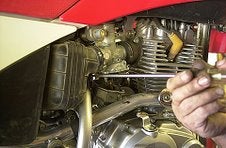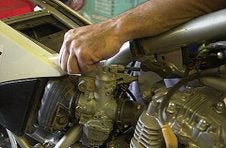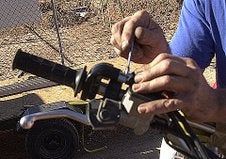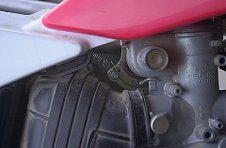 While we truly liked our Honda Project Bike and what it had become,
there was still something that bothered us about it … a great deal.
You see, the Honda has a "lurch" right off of idle that drives you
nuts at low rpm in the bottom two gears.
While we truly liked our Honda Project Bike and what it had become,
there was still something that bothered us about it … a great deal.
You see, the Honda has a "lurch" right off of idle that drives you
nuts at low rpm in the bottom two gears.
This point was driven home when my old buddy Tom flew in to visit and
stayed about ten days. Naturally, we went riding a whole bunch of
times in that period. Since Tom also had a 230 Honda, he was eager to
ride ours. When he did, he noted that our Honda had the same "lurch"
as his did. We
talked with some other Honda 230 owners, and they reported the same thing.
Let's try to describe that "lurch" to you. In first or second gear at
low speeds, when you try to roll the throttle on, you get an immediate
response that's hard to control. This is exactly the kind of thing
you don't need when trail riding on tight trails. When you consider
that the CRF230 is designed for beginning riders, or people who want a
mellow trail bike, this is confusing. Imagine, if you will, trying to
teach a 14 year-old kid to ride on a 230 and having a burst of power
right off idle that scares the poor kid half way to brown shorts city.
The point was driven home when Tom rode our Project TTR230 Yamaha on
the same day. When you wanted a little more power, you just twisted
the throttle a bit more and the friendly engine responded nicely. Do
the same on the Honda, and the bike would bolt forward with the newbie
rider hanging on for dear life.
We concurred: the bike to have would be the Honda chassis with the
Yamaha motor installed.
Failing this, we thought that perhaps a carb swap would be the answer. A call to Keith Lynas, the Ossa guru, informed us that this sort of
swap would be a nightmare. In desperation, we called Stephen
Gautreau, owner of SG Cycles (Mesa, Arizona, 5635 E. Baseline Rd.,
602-705-5876) and asked for some advice. He responded: "No sweat.
I've already done about seven 230s for that very same problem."
Within the hour, we had the Honda loaded up and headed for his shop.
Stephen told us that the problem was that the Honda (even stone stock)
was jetted horribly lean down low. We thought that the problem was
solved in our Project Bike when we installed the Power Up kit with a
42S pilot jet and a bigger main jet. Not enough, said Stephen.
He proceeded to remove the saddle and loosen the gas tank for access
to the carb (the average guy might have to remove the tank and the
side panels). He removed the four screws holding the float bowl and
lowered it. This gave him access to the jets without removing the
carb. Of course, the carb clamps had to be loosened a bit to rotate
the carb.
The emulsion tube had to be removed to get to the pilot jet. A really
short screwdriver will be needed for this. The 42S pilot was removed
and replaced with a 48 jet. This is a standard Keihin jet and any
well stocked Honda dealer should have it. After the jet is changed,
the bowl is screwed back in place and then the fuel mixture screw on
the bottom of the float bowl can taken out to ¾ turn.
Then the top of the carb had to be taken off and the slide removed.
The needle had to be taken out and the position made a bit richer. To
do this, the clip was lowered one notch and this raised the needle,
making the transition from low rpm to mid-range smoother. After
buttoning up the carb, Tom took it for a ride and then Stephen rode
the bike. The response was markedly better, but still not quite
right. Stephen worked on the throttle cable adjusters and loosened
them up substantially. The combination of these things helped a
bunch. The lurch was almost gone.
To finalize the carb tuning, a small spring was installed on the "pull" cable.
We had to drill a small hole in the throttle cam and another in
plastic air box top. What kind of spring? Well, we got ours for 59
cents at Ace Hardware. You're going to have to experiment a bit and
find out what weight spring will be best for you.
Once the spring was installed, the difference in the throttle response
was incredible. The combination of the richer pilot jet, the change
in the fuel mixture screw and the throttle spring yielded a decent
throttle response. The "lurch" was almost gone. Our guess-timate was
that we had an 85 percent improvement. This made the 230 Honda very
easy to ride.
It makes one wonder why Honda didn't do what we did. The bike was
intended to be a mellow, easy to ride bike. It isn't … until we got
hold of it.
Go to PAGE 2 to see the How To in pictures, step by step.
 |
 |
| In first or second gear at low speeds with our CRF230, you get an immediate response that's hard to control. Let's fix that. | Remove the screws holding the float bowl in place. |
 |
 |
| Float bowl can now be lowered. | Stephen Gatreau found the area tight... |
 |
 |
| ... so the carb clamps were loosened and the carb rotated. | Remove the emulsion tube so the pilot jet can be reached. |
 |
 |
| Pilot jet can now be removed. | A really short screwdriver is needed to get the pilot jet out. |
 |
 |
| Stephen checked the small numbers on the pilot jet and settled on a 48 Keihin | The top of the carb was taken off. |
 |
 |
| With the carb top off, the slide can be taken out. | Remove the needle and lower the clip on position. This lowers the needle and richens the transmission. |
 |
 |
| Button everything back up. | Loosen the cable adjusters so there is some free play in the throttle. |
 |
 |
| Drill a small hole in the throttle cam to hook a spring into. | Another small hole is drilled in the plastic to hook the back of the spring to. |
 |
 |
| Stephen and Tom rode the bike and anaylzed the new performance. | Success! The lurch is dimished and the 230 is much easier to ride. |


 Your Privacy Choices
Your Privacy Choices